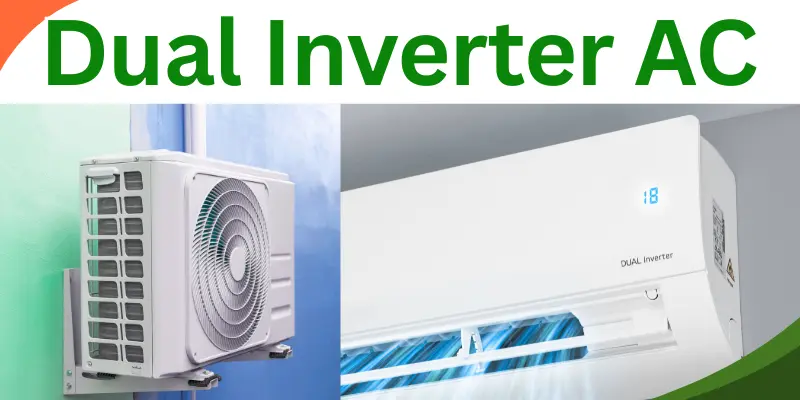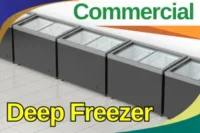What Is a Dual Inverter Air Conditioner – Complete Beginner Guide
Published: 23 Oct 2025
Have you ever heard the term and wondered, What is a dual inverter air conditioner? It sounds fancy, right? Many people get confused when they first hear it. But don’t worry, you’re in the right place. In this guide, we’ll walk you through what it means, how it works, and why it’s different from regular ACs. By the end, you’ll easily understand why so many homes are switching to this smart cooling option.
So, guys, are you ready? Let’s discuss in detail without wasting time.
Definition of Dual Inverter Air Conditioner
A dual-inverter air conditioner is a type of AC that uses two rotors inside its compressor instead of one. These rotors work together to control the speed of the compressor more smoothly. Because of this, the AC can cool the room faster and use less electricity. It does not need to switch on and off often, which also helps reduce power use.

This design makes the AC quieter while running. It also keeps the temperature steady without sudden changes. In simple words, a dual inverter AC gives better cooling, saves energy, and lasts longer than a normal one. It is a smart choice for homes that need comfort and low power bills.
Importance of a Dual Inverter Air Conditioner
A dual-inverter AC is not just about cooling your room. It also helps you save energy, enjoy peace, and get steady comfort every day. Here’s why it is important for your home:
- Saves electricity – Uses less power compared to normal ACs.
- Cools faster – Reaches the set temperature more quickly.
- Runs quietly – Makes very little noise while working.
- Lasts longer – Has a strong and durable compressor.
- Keeps temperature steady – No sudden rise or drop in cooling.
- Reduces bills – Lower energy use means smaller electricity bills.
How a Dual Inverter Air Conditioner Works
A dual inverter AC works smartly and simply. It uses two rotors inside its compressor to control cooling smoothly. This helps the AC adjust its speed instead of turning on and off again and again. Here’s how it works step by step:
- The AC checks the room temperature with built-in sensors.
- The compressor starts running and adjusts its speed as needed.
- Two rotors inside the compressor work together to make cooling smooth and fast.
- When the room gets cool enough, the compressor slows down but doesn’t stop.
- This keeps the temperature steady without sudden changes.
- The AC uses less electricity because it avoids restarting again and again.
- The result is quiet, fast, and energy-saving cooling for your home.
Types of Dual Inverter Air Conditioner
Dual inverter ACs come in different types to fit different homes and needs. Each type works on the same cooling idea but has its own features and setup. Here are the most common types you can find:
- Split Dual Inverter AC – Comes with two units, one inside and one outside, perfect for homes and bedrooms.
- Window Dual Inverter AC – Fits in a window frame and is good for small rooms.
- Portable Dual Inverter AC – Can be moved from one room to another and needs no fixed installation.
- Cassette Dual Inverter AC – Installed in the ceiling, best for offices or large halls.
- Tower Dual Inverter AC – Stands on the floor and cools big areas quickly.
Advantages and Disadvantages of a Dual Inverter Air Conditioner
In this section, we will look at the pros and cons of using a dual inverter air conditioner. Knowing both sides will help you decide if it’s the right choice for your home.
Advantages of a Dual Inverter Air Conditioner
A dual inverter AC offers many useful benefits that make cooling easier and smarter.
- Uses less electricity and saves money on bills.
- Cools the room faster than a normal AC.
- Runs quietly without loud compressor sounds.
- Keeps the room temperature steady and comfortable.
- Lasts longer due to smooth compressor operation.
- Works well even during voltage changes.
- Reduces wear and tear on parts, lowering repair needs.
Disadvantages of a Dual Inverter Air Conditioner
Even with many benefits, there are a few points to keep in mind before buying.
- Costs more than a normal inverter AC.
- Repairs or parts may be a bit expensive.
- Needs proper installation by trained technicians.
- It may not show big savings if used for short hours only.
Mistakes to Avoid When Using a Dual Inverter AC
In this section, we cover the common mistakes people make while using a dual inverter air conditioner. Avoiding these mistakes can help your AC work better and last longer. Take a look at the key points below:
- Ignoring regular cleaning – Dust on filters and vents blocks airflow and reduces cooling.
- Setting the temperature too low – It does not cool faster; it only increases power use.
- Skipping maintenance – Not getting the AC serviced on time can cause compressor problems.
- Wrong installation spot – Placing the indoor unit near sunlight or heat sources affects cooling.
- Not closing doors and windows – Cool air escapes, making the AC work harder.
- Using old wiring or plugs – It can harm the compressor or reduce performance.
- Running the AC nonstop – Giving it short breaks helps save energy and keeps it in good shape.
Misconceptions About Dual Inverter AC
In this section, we cover the common misconceptions people have about dual inverter air conditioners. Many users believe a few things that sound right but are actually wrong. Let’s clear up these points so you can understand your AC better.
- “Dual inverter ACs use more power.” – They actually use less power because the compressor runs at a steady speed.
- “They need more maintenance.” – Regular cleaning and yearly servicing are enough, just like any normal AC.
- “They cool too slowly.” – They cool faster because the dual rotors help maintain smooth and quick cooling.
- “They are only for large rooms.” – You can find models made for small and medium rooms, too.
- “They don’t work well during power changes.” – Most models handle voltage changes better than older types.
- “They are not worth the price.” Though the cost is higher at first, the long-term power savings make them a smart buy.
Best Practices for Using a Dual Inverter AC
In this section, we cover the best ways to use a dual inverter air conditioner for better cooling and longer life. Following these simple tips can help you save energy and enjoy steady comfort every day.
- Clean the filters often – Wash or replace filters every few weeks to keep airflow smooth.
- Set the right temperature – Keep it around 24–26°C for the best cooling and power savings.
- Close doors and windows – This keeps cool air inside and helps the AC work efficiently.
- Get regular servicing – Have a technician check your AC at least once a year.
- Keep outdoor unit clear – Make sure there’s no dust, leaves, or blockage around it.
- Use energy-saving mode – It helps the AC run quietly and reduces electricity use.
- Turn off when not needed – Switch off the AC when you leave the room for a long time.
- Use curtains or blinds – They help block sunlight and keep the room cooler.
Future of Dual Inverter Air Conditioners
In this section, we cover how dual-inverter air conditioners are shaping the future of home cooling. As technology keeps improving, these ACs are becoming smarter, more efficient, and easier to use. Here’s what the future looks like for them:
- More energy savings – New models will use even less power while giving better cooling.
- Smart control options – You’ll be able to control temperature and modes through mobile apps or voice commands.
- Eco-friendly gases – Future ACs will use gases that are safer for the environment.
- Compact and stylish designs – Models will get smaller, lighter, and better looking.
- Self-cleaning features – Built-in cleaning systems will keep filters and coils clean automatically.
- Better air quality – Advanced filters will remove dust, smoke, and germs more effectively.
- Longer lifespan – Improved compressors and parts will make them last for many years.
Conclusion
So guys, now you know what is a dual inverter air conditioner. and how it works. We’ve covered its types, benefits, working process, and even the common mistakes people make. You also learned about its future and why it’s becoming a smart choice for modern homes. If you’re planning to buy a new AC, I’d personally recommend going for a dual inverter model. It saves power, cools faster, and gives lasting comfort. Stay tuned, buddies – there’s always more to learn about keeping your home cool and comfy!
Common Questions and Answers
Many people have common doubts before buying a dual inverter air conditioner. In this section, you’ll find clear and simple answers to help you understand how it works, why it’s useful, and what makes it different from a regular AC.
A dual-inverter air conditioner is a modern type of AC that uses two rotors inside its compressor. These rotors move together to control the cooling speed more smoothly. This helps the AC cool faster without using too much power. It also runs quietly, giving you comfort without any loud noise.
Yes, it is worth paying a bit more for a dual inverter AC. It saves you money in the long run by using less electricity each month. The cooling is faster, and the compressor lasts longer because it works more smoothly. So even though the starting price is higher, it pays off over time.
Yes, it truly helps save electricity. The compressor in this AC adjusts its speed based on how cool the room needs to be. It does not keep switching on and off like normal ACs, which wastes power. This steady operation keeps energy use low and makes it more efficient.
Yes, a dual-inverter AC cools the room faster than a regular one. The twin rotors allow the compressor to run at a higher speed when the room is hot. Once the room reaches the set temperature, it slows down to maintain comfort. This gives you quick and even cooling without sharp temperature changes.
In most cases, you may not need a voltage stabilizer for a dual inverter AC. These models are designed to handle small voltage changes on their own. However, if your area often faces big power drops or spikes, using a stabilizer is a good idea. It helps protect the AC’s compressor and other parts from damage.





